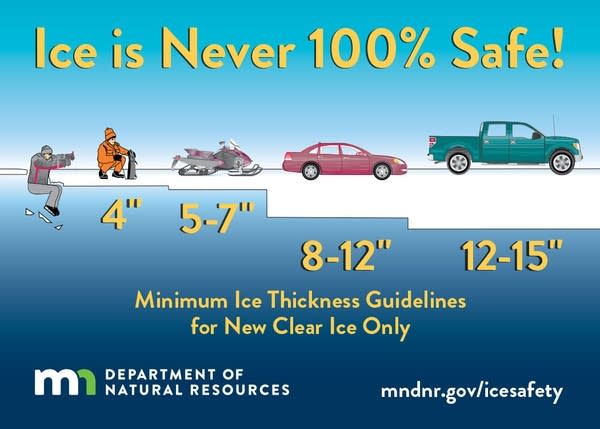3 bits of wisdom as you test the lake ice this winter

Go Deeper.
Create an account or log in to save stories.
Like this?
Thanks for liking this story! We have added it to a list of your favorite stories.
Department of Natural Resources conservation officer Garrett Thomas brought ice picks, lifejackets, augers and some common sense to an Eagan park Thursday, hoping to keep Minnesotans safe as they venture onto frozen lakes this winter.
While Minnesotans have a long history with ice, there are still stories every year of people who were overconfident about the strength of the ice below them and unprepared to respond when it broke. This is the time of year when bad things happen.
There were six deaths on the ice in 2017 — five of them in late November and early December, when the ice was not thick enough to take on weight, according to the DNR.
"There's a lot more fishermen going out, ATVs, snowmobiles," said Thomas, "so it's very important that you're safe when you're out there. I think the biggest mistake people make is getting too eager to get out there to catch some fish. That's when people get in trouble and fall through, or they bring out vehicles too early."
Turn Up Your Support
MPR News helps you turn down the noise and build shared understanding. Turn up your support for this public resource and keep trusted journalism accessible to all.
At Holland Lake in Lebanon Hills Regional Park, Thomas demonstrated the basics of being smart on the ice.
1) Don't guess
Trusting your gut is not the best path on the ice. To that end, Thomas demonstrated the use of an auger and tape measure to drill a hole in the ice and measure its thickness.
Thomas also said that ice thickness will change depending on where you are, and that it's best to measure every 150 feet or so.
"Here we have about 6 inches of ice," he said, gesturing at the hole he just drilled. "But just over there, which is only about 10 yards behind me, you only have 5 inches of ice."
The DNR's ice thickness guidelines call for at least 4 inches of new, clear ice beneath your feet as you walk. The number goes up as vehicles like snowmobiles, cars and trucks come into play.

Be prepared
Thomas also talked about the importance of knowing your equipment, and how it could be more dangerous if you used them incorrectly.
For instance, a float coat, could be lifesaving for people going out on foot, but life-threatening for people in vehicles.
"Because if a truck or car goes through the ice, and you're stuck in there with your float coat, you're going to float to the surface, and it's going to be harder to get out," he said.
Know what to do if the ice gives way
Thomas concluded with the ice picks, and what to do if you do fall in the water. The main thing? Stay calm. The goal is not to stand but to drag yourself onto the ice while spreading your weight out as much as possible. Pull yourself and cover the most surface area to prevent the ice from cracking.
"It's going to be scary," he said. "Hopefully you'll have your ice picks with you, and you can pull yourself out of the ice."
Dear reader,
Political debates with family or friends can get heated. But what if there was a way to handle them better?
You can learn how to have civil political conversations with our new e-book!
Download our free e-book, Talking Sense: Have Hard Political Conversations, Better, and learn how to talk without the tension.




